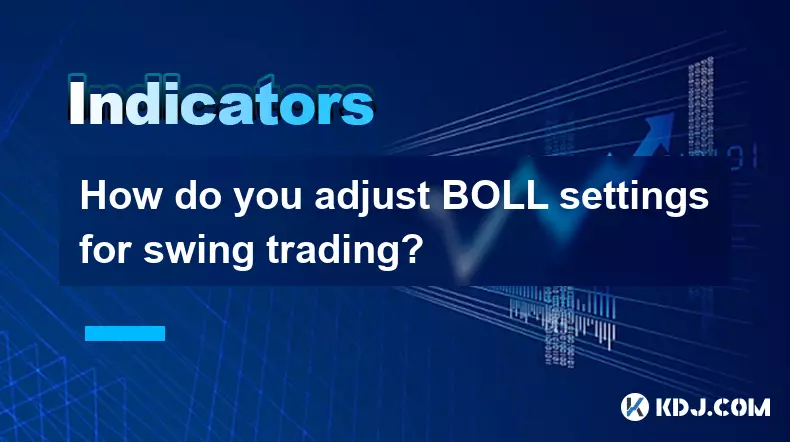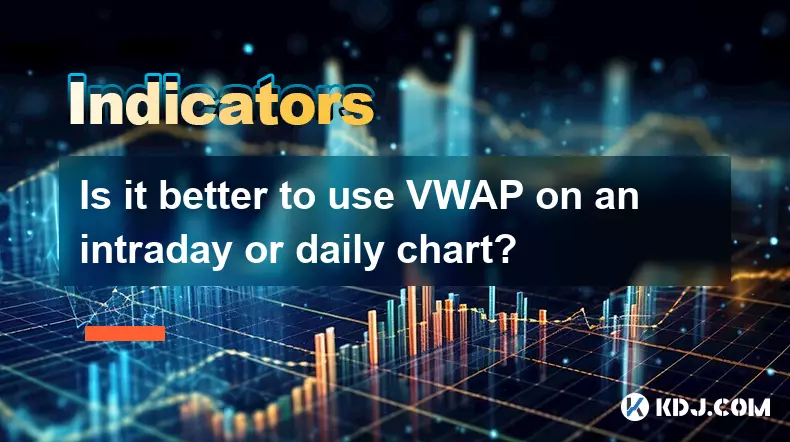-
 bitcoin
bitcoin $112715.707551 USD
-1.71% -
 ethereum
ethereum $4101.475385 USD
-3.01% -
 tether
tether $1.000644 USD
-0.02% -
 bnb
bnb $1207.619465 USD
-6.77% -
 xrp
xrp $2.501451 USD
-3.98% -
 solana
solana $202.947124 USD
-3.32% -
 usd-coin
usd-coin $1.000295 USD
0.04% -
 dogecoin
dogecoin $0.203884 USD
-4.47% -
 tron
tron $0.317154 USD
-1.72% -
 cardano
cardano $0.695009 USD
-4.43% -
 hyperliquid
hyperliquid $38.853961 USD
-8.23% -
 chainlink
chainlink $18.988674 USD
-4.64% -
 ethena-usde
ethena-usde $1.000233 USD
-0.03% -
 stellar
stellar $0.337050 USD
-3.63% -
 bitcoin-cash
bitcoin-cash $536.861728 USD
-1.28%
How do you adjust BOLL settings for swing trading?
Bollinger Bands help swing traders identify volatility, overbought/oversold levels, and potential breakouts, especially when combined with volume, RSI, or MACD for confirmation.
Oct 10, 2025 at 09:18 am

Understanding BOLL in Swing Trading Context
1. The Bollinger Bands (BOLL) indicator consists of three lines: the middle band, typically a 20-period simple moving average, and upper and lower bands that represent standard deviations from the mean. These bands dynamically expand and contract based on market volatility, making them particularly useful for identifying potential price breakouts or reversals.
2. In swing trading, where positions are held from several days to weeks, traders rely on BOLL to detect overbought and oversold conditions within a broader trend. When price touches or exceeds the upper band, it may signal a short-term top; when it hits the lower band, it could indicate a temporary bottom.
3. Standard BOLL settings use a period of 20 and two standard deviations. However, these default values may not align with all assets or market environments. Adjusting these parameters allows traders to fine-tune sensitivity and reduce false signals during sideways or choppy markets.
4. A key advantage of BOLL in swing trading is its ability to visualize volatility compression, often preceding significant price moves. Tightening bands suggest low volatility, potentially setting the stage for explosive breakout movements that swing traders aim to capture.
Optimizing the Period Length for Market Cycles
1. Extending the moving average period from 20 to 28 or 34 can help filter out noise and provide more reliable signals in trending markets. Longer periods smooth the middle line, reducing whipsaws caused by short-term fluctuations.
2. For assets with longer consolidation phases, such as major cryptocurrencies like Bitcoin or Ethereum, using a 30-period SMA instead of 20 helps align the indicator with the natural rhythm of weekly price swings.
3. Shorter periods like 14 or 16 increase responsiveness, beneficial in fast-moving altcoin markets. While this adjustment captures early entries, it also increases the risk of premature signals during minor retracements.
4. Traders should backtest different period lengths against historical price action to determine which setting produces consistent results across multiple cycles without curve-fitting to past data.
Modifying Standard Deviation for Signal Precision
1. Reducing the standard deviation from 2.0 to 1.8 can narrow the bands, increasing the frequency of touchpoints and improving sensitivity in range-bound markets. This change suits strategies focused on mean reversion within established channels.
2. Increasing deviation to 2.5 widens the bands, requiring stronger momentum for price to reach them. This adjustment reduces false breakouts and is effective during high-volatility events like exchange listings or macroeconomic announcements.
Using a deviation of 2.2 to 2.4 in conjunction with volume analysis enhances confirmation of breakout validity, especially when price closes beyond the band with elevated trading activity.3. Dynamic deviation models, though less common, adjust the multiplier based on real-time volatility metrics such as Average True Range (ATR), offering adaptive responsiveness without manual recalibration.
Combining BOLL with Supporting Indicators
1. Pairing BOLL with RSI helps distinguish between genuine breakouts and fakeouts. For example, if price touches the upper band while RSI exceeds 70, the setup suggests overbought pressure and a higher probability of pullback.
2. Volume profile integration reveals whether price interactions with bands occur on strong participation. A spike in volume when price breaches the upper band supports continuation; weak volume suggests exhaustion.
Incorporating MACD crossovers as a secondary filter ensures alignment between BOLL-based entry points and underlying momentum direction, minimizing countertrend trades.3. Candlestick patterns near band extremes—such as pin bars or engulfing formations—add confluence, increasing confidence in reversal setups when combined with proper BOLL configuration.
Frequently Asked Questions
What time frame is best for BOLL in swing trading?The daily chart is most commonly used, providing a balance between signal reliability and trade frequency. Some traders also use the 12-hour or 8-hour charts to refine entries while maintaining a swing-oriented approach.
Can BOLL be used alone for trade decisions?While BOLL provides valuable insights into volatility and potential turning points, relying solely on it increases exposure to false signals. It performs best when integrated with other technical tools and structural analysis.
How do you handle BOLL during strong trends?In persistent uptrends or downtrends, price may 'ride' the upper or lower band. Instead of assuming reversal, traders should interpret sustained contact as momentum strength and look for shifts in band slope or width to anticipate trend fatigue.
Disclaimer:info@kdj.com
The information provided is not trading advice. kdj.com does not assume any responsibility for any investments made based on the information provided in this article. Cryptocurrencies are highly volatile and it is highly recommended that you invest with caution after thorough research!
If you believe that the content used on this website infringes your copyright, please contact us immediately (info@kdj.com) and we will delete it promptly.
- Zero Knowledge Proof, Whitelist, Blockchain 2025: The Dawn of Private, Scalable Infrastructure
- 2025-10-16 01:20:01
- Altcoins, Whales, and Tariff Threats: Navigating the Crypto Seas
- 2025-10-16 01:20:01
- ChatGPT's Crystal Ball: HBAR Price Prediction and the Rise of Snorter in 2025
- 2025-10-16 01:20:01
- ZEROBASE Listing and Airdrop: A New Era for ZK Tech?
- 2025-10-16 00:25:13
- Digital Euro, Gold Standard, and Active Reserves: A New York Minute on the Future of Money
- 2025-10-16 00:25:13
- TCG OTS Pack Spoilers: What's Hot and What's Not?
- 2025-10-16 00:33:47
Related knowledge

What's the main difference between VWAP and TWAP?
Oct 12,2025 at 11:54am
Understanding VWAP and Its Role in Crypto Trading1. Volume Weighted Average Price (VWAP) is a trading benchmark that calculates the average price of a...

How do you identify exhaustion moves using VWAP and its bands?
Oct 12,2025 at 08:00am
Understanding the Role of Decentralized Exchanges in Crypto Trading1. Decentralized exchanges (DEXs) operate without a central authority, allowing use...

Is it better to use VWAP on an intraday or daily chart?
Oct 15,2025 at 02:01am
Intraday Trading and the Role of VWAP1. Intraday traders frequently rely on VWAP (Volume Weighted Average Price) as a dynamic benchmark for assessing ...

How do you use VWAP to scale in and out of positions?
Oct 14,2025 at 02:19am
Understanding VWAP as a Dynamic Benchmark1. The Volume Weighted Average Price (VWAP) is not just an indicator—it functions as a dynamic benchmark that...

What are the main advantages of using VWAP over EMA?
Oct 11,2025 at 02:18am
Main Advantages of Using VWAP Over EMA1. Volume-Weighted Average Price (VWAP) incorporates trading volume into its calculation, offering a more accura...

How do you use VWAP on different chart types like Heikin Ashi?
Oct 11,2025 at 05:01pm
Understanding VWAP in the Context of Heikin Ashi Charts1. The Volume Weighted Average Price (VWAP) is a powerful analytical tool commonly used by trad...

What's the main difference between VWAP and TWAP?
Oct 12,2025 at 11:54am
Understanding VWAP and Its Role in Crypto Trading1. Volume Weighted Average Price (VWAP) is a trading benchmark that calculates the average price of a...

How do you identify exhaustion moves using VWAP and its bands?
Oct 12,2025 at 08:00am
Understanding the Role of Decentralized Exchanges in Crypto Trading1. Decentralized exchanges (DEXs) operate without a central authority, allowing use...

Is it better to use VWAP on an intraday or daily chart?
Oct 15,2025 at 02:01am
Intraday Trading and the Role of VWAP1. Intraday traders frequently rely on VWAP (Volume Weighted Average Price) as a dynamic benchmark for assessing ...

How do you use VWAP to scale in and out of positions?
Oct 14,2025 at 02:19am
Understanding VWAP as a Dynamic Benchmark1. The Volume Weighted Average Price (VWAP) is not just an indicator—it functions as a dynamic benchmark that...

What are the main advantages of using VWAP over EMA?
Oct 11,2025 at 02:18am
Main Advantages of Using VWAP Over EMA1. Volume-Weighted Average Price (VWAP) incorporates trading volume into its calculation, offering a more accura...

How do you use VWAP on different chart types like Heikin Ashi?
Oct 11,2025 at 05:01pm
Understanding VWAP in the Context of Heikin Ashi Charts1. The Volume Weighted Average Price (VWAP) is a powerful analytical tool commonly used by trad...
See all articles










































































